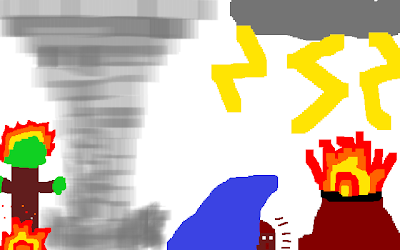Tornado
A tornado is a violently rotating column of air that is in
contact with both the surface of the earth and a cumulonimbus cloud or, in rare
cases, the base of a cumulus cloud. They are often referred to as twisters or
cyclones, although the word cyclone is used in meteorology, in a wider sense,
to name any closed low pressure circulation.
Tsunami
Tsunami waves do not resemble normal sea waves, because
their wavelength is far longer. Rather than appearing as a breaking wave, a tsunami
may instead initially resemble a rapidly rising tide, and for this reason they
are often referred to as tidal waves. Tsunamis generally consist of a series of
waves with periods ranging from minutes to hours, arriving in a so-called
"wave train".
Earth quake
An earthquake (also known as a quake, tremor or temblor) is
the result of a sudden release of energy in the Earth's crust that creates
seismic waves. The seismicity, seismism or seismic activity of an area refers
to the frequency, type and size of earthquakes experienced over a period of
time.
Bush Fire
Bush fires in Australia are frequently occurring events
during the hotter months of the year due to Australia's mostly hot, dry
climate. Large areas of land are ravaged every year by bush fires, which also
cause property damage and loss of life.
Eruption
During a volcanic eruption, lava, tephra (ash, lapilli,
volcanic bombs and blocks), and various gases are expelled from a volcanic vent
or fissure. Several types of volcanic eruptions have been distinguished by
volcanologists. These are often named after famous volcanoes where that type of
behavior has been observed. Some volcanoes may exhibit only one characteristic
type of eruption during a period of activity, while others may display an
entire sequence of types all in one eruptive series.
Avalanche
An avalanche (also called a snow slide or snow slip) is a
rapid flow of snow down a slope. Avalanches are typically triggered in a
starting zone from a mechanical failure in the snow pack (slab avalanche) when
the forces on the snow exceed its strength but sometimes only with gradually
widening (loose snow avalanche). After initiation, avalanches usually
accelerate rapidly and grow in mass and volume as they entrain more snow. If
the avalanche moves fast enough some of the snow may mix with the air forming a
powder snow avalanche, which is a type of gravity current.
My top 10 natural disasters are:
1.
1992 Hurricane Andrew: Not very deadly but cost
billions in repairs.
2.
2005 Hurricane Katrina: Deadly and cost lots of
money.
3.
2008 Sichuan Earthquake with aftershocks: Killed
many and cost lots of money.
4.
2008 Cyclone Nargis: Killed many and costs
billions
5.
2011 Japan Earthquake and tsunami: Killed
millions and costs billions to repair and everything was destroyed with a 9 on
the scale of the earthquake and created a deadly tsunami.
6.
1976 Tangshan Earthquake: 7 on the scale
aftershock what killed millions and costs billions in repair.
7.
2004 Indian Ocean Earthquake and Tsunami: costs
billions and killed many people during the earthquake and a 9.3 earthquake.
8.
1970 Bhola Cyclone: Deadliest Cyclone in
recorded history and killed millions also most people died in the massive
flooding.
9.
2010
Haiti Earthquake: a 7.0 earthquake that shacked the country and killed
millions.
10.
1931 China Central floods: Deadliest natural
disaster in natural history and killed millions most people died from drowning.
Here are some
more disasters:
·
2011 New Zealand earthquake
·
Australia’s inland cyclone and tsunami
·
2012 Fiji Cyclone
My drawing of natural disasters (Bush fire, tornado, tsunami, eruption and lightning.










